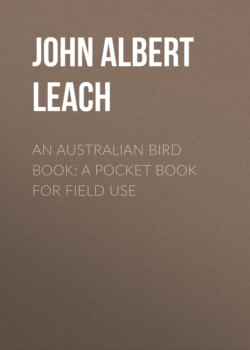Читать книгу An Australian Bird Book: A Pocket Book for Field Use - John Albert Leach - Страница 15
На сайте Литреса книга снята с продажи.
Sub-Class II.—Neognathae. Carinatae, minus Tinamidae. ORDER II.—GALLIFORMES.
ОглавлениеTable of Contents
F. 7. MEGAPODIIDAE (4), Mound-Builders, Scrub-Fowl, Brush Turkey, Megapode, 28 sp.—27(25)A., 3(1)O.
1
1
2* Mallee-Fowl, Lowan, Native Pheasant, Pheasant (e), Leipoa ocellata, N.S.W., V., S.A., W.A.
Stat. r. mallee scrubs 24
Like a small turkey; neck light fawn-gray; back, wings spotted white, black, brown; f., smaller. Seeds, ants.
F. 8. Cracidae, Curassows, Guans, 59 sp.—1(0)Nc., 59(58)Nl.
F. 9. Tetraonidae, Grouse, Capercailly, Ptarmigan, Prairie-Fowl, 45 sp.—1(0)O., 19(16)P., 28(26)Nc.
F. 10. PHASIANIDAE (6), Pheasants, Partridges, Peafowl, Domestic Fowls, 242 sp.—12(10)A., 137(119)O., 47(31)P., 64(58)E.
1
6
3* Stubble Quail (Pectoral), Coturnix pectoralis, A., T. =vt. Eur. Quail.
Nom. c. stubble, grass 6.7
Brown lined white, black; throat dull reddish; breast streaked black; f., less distinctly marked with black. Weed-seeds, insects. Rises with a burr-r-r.
3
7
4* Brown Quail (Swamp, Partridge), Synoicus australis, N.G., A., T. =vt. Eur. Partridge.
Nom. c. grassy flats 6.5
Upper finely-barred gray, black, chestnut; under buffy-gray with zigzag black bars; bill blue, tipped black; eyes orange; f., sim. Seeds, insects. "Bee'e quick."
5 Tasmanian Quail (Silver, Greater-Brown), S. diemenensis, V., T. Like 4, but larger.
Nom. r. occ. thick grass 8.5
1
4
6* King Quail (Chestnut-bellied, Least, Dwarf, Swamp), Excalfactoria chinensis lineata, Philippines, Sumatra to A. exc. W.A.; sub-species of Chinese Quail.
Nom. r. swamps 4.5
Back dark-brown; breast blue-gray; abdomen chestnut; throat black, white bands conspicuous; 1¼ oz.; f., dark-brown, spotted black; throat whitish; under barred black. Weed-seeds, insects.
F. 11. Numididae, Guinea-Fowls, 23 sp. E.
F. 12. Meleagridae, Turkeys, 5 sp.—4(2)Nc., 3(1)Nl.
F. 13. Odontophoridae, American Quails, Bob-Whites, 72 sp.—18(10)Nc., 62(54)Nl.
Order III. comprises the 26 Bustard Quail and the peculiar Australian Plain Wanderer. Only the last species of this Bustard Quail family, the Australian Plain Wanderer has the hind toe. The females of this order of birds do the fighting.
In Quail, the rule often observed amongst birds that the male is larger and more beautiful than the female may be reversed, for here the female is sometimes larger and the more conspicuously colored. In association with this reversal of color and size, the domestic habits are changed, for, in some species at least, the female sits on the eggs but a very short time; the male then finishes the task of incubating, and brings up and educates the young family. Meantime, the female has found another mate and another clutch of eggs is left to the care of the male.
In birds having both sexes the same color each bird usually does its share of domestic work, sitting on the eggs, feeding the young, etc. Where the male is more brightly colored, he, as a rule, does not sit on the eggs, for he would be visible to a bird of prey sailing overhead, and so would probably be killed and the eggs taken. The great naturalist, Alfred Russel Wallace, thus regards the quiet coloration of most female birds as a protection during the nesting season. The gaudy coloration of many male birds has been explained by Darwin as being due to sexual selection, the female choosing as a mate the most gaily colored or most attractive bird.
Though the sitting bird is usually protectively colored, it was our good fortune, on a Summer School excursion, attended by His Excellency the Governor (Sir Thomas Gibson-Carmichael), a keen Nature-lover, and the Director of Education (Mr. F. Tate), to find the gorgeously-colored male Golden-breasted Whistler (Thickhead) sitting on the eggs in full daylight. It was noted, however, that the open nest was unusually well protected by an overhead bushy branch.
